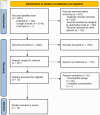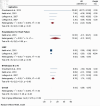Prevalence, Clinical Manifestations, and Adverse Outcomes of Left Ventricular Noncompaction in Adults: A Systematic Review and Meta-Analysis
- PMID: 39420976
- PMCID: PMC11483115
- DOI: 10.14740/cr1673
Prevalence, Clinical Manifestations, and Adverse Outcomes of Left Ventricular Noncompaction in Adults: A Systematic Review and Meta-Analysis
Abstract
Background: Left ventricular noncompaction (LVNC) is recognized within the spectrum of adult cardiomyopathies for its unique pathophysiologic features and clinical challenges. This condition exhibits a wide range of clinical manifestations, from asymptomatic states to severe cardiovascular complications, making its diagnosis and management challenging. This study aimed to synthesize current data on the prevalence, diagnostic methods, clinical outcomes, and treatment efficacy of LVNC in adults to address gaps in understanding and management strategies.
Methods: A systematic review and meta-analysis of research from 2000 to March 2024 was conducted, focusing on studies involving adults diagnosed with LVNC. This approach aimed to collect data on the prevalence of LVNC, the diagnostic accuracy of different imaging modalities, clinical manifestations, and the impact of different treatment strategies.
Results: The study showed a prevalence of LVNC of 0.5%, with cardiovascular magnetic resonance outperforming echocardiography in diagnosis with a detection rate of 1.3%. Mortality and heart transplantation rates were 12% and 7%, respectively. Significant predictors of adverse outcomes included New York Heart Association (NYHA) class III or IV, ventricular tachycardia, and reduced left ventricular ejection fraction (LVEF), guiding a nuanced approach in tailoring therapeutic strategies to optimize patient care and outcomes.
Conclusions: This study advances the understanding of LVNC by refining diagnostic criteria and evaluating management strategies, highlighting the superiority of cardiovascular magnetic resonance. It identifies predictors of adverse outcomes and assesses treatment efficacy, urging precision in diagnosis and tailored treatments. Its comprehensive analysis and methodological rigor make it a key resource advocating a multidisciplinary approach to improve patient outcomes in LVNC.
Keywords: Cardiovascular magnetic resonance; Clinical outcomes; Diagnostic criteria; Left ventricular noncompaction; Treatment strategies.
Copyright 2024, Llerena-Velastegui.
Conflict of interest statement
The author declares no conflict of interest to ensure the impartiality of the study.
Figures











Similar articles
-
Prevalence and Prognostic Significance of Left Ventricular Noncompaction in Patients Referred for Cardiac Magnetic Resonance Imaging.Circ Cardiovasc Imaging. 2017 Sep;10(9):e006174. doi: 10.1161/CIRCIMAGING.117.006174. Circ Cardiovasc Imaging. 2017. PMID: 28899950
-
Advances and challenges in the diagnosis and management of left ventricular noncompaction in adults: A literature review.Curr Probl Cardiol. 2024 Jun;49(6):102571. doi: 10.1016/j.cpcardiol.2024.102571. Epub 2024 Apr 10. Curr Probl Cardiol. 2024. PMID: 38608914 Review.
-
Comparison of cardiovascular magnetic resonance characteristics and clinical prognosis in left ventricular noncompaction patients with and without arrhythmia.BMC Cardiovasc Disord. 2022 Feb 2;22(1):25. doi: 10.1186/s12872-022-02470-7. BMC Cardiovasc Disord. 2022. PMID: 35109817 Free PMC article.
-
Prognostic Significance of Left Ventricular Noncompaction: Systematic Review and Meta-Analysis of Observational Studies.Circ Cardiovasc Imaging. 2020 Jan;13(1):e009712. doi: 10.1161/CIRCIMAGING.119.009712. Epub 2020 Jan 21. Circ Cardiovasc Imaging. 2020. PMID: 31959004 Free PMC article.
-
Left ventricular noncompaction cardiomyopathy: updated review.Ther Adv Cardiovasc Dis. 2013 Oct;7(5):260-73. doi: 10.1177/1753944713504639. Ther Adv Cardiovasc Dis. 2013. PMID: 24132556 Review.
References
-
- Mendpara V, Endreddy JKR, Gajula S, Ravulapalli P, Kumar M, Kaur P, Thakkar M. Overlapping phenotypes of alcoholic cardiomyopathy and left ventricular non-compaction: a case report and discussion of converging cardiomyopathies. Cureus. 2023;15(11):e48220. doi: 10.7759/cureus.48220. - DOI - PMC - PubMed
-
- Aung N, Doimo S, Ricci F, Sanghvi MM, Pedrosa C, Woodbridge SP, Al-Balah A. et al. Prognostic significance of left ventricular noncompaction: systematic review and meta-analysis of observational studies. Circ Cardiovasc Imaging. 2020;13(1):e009712. doi: 10.1161/CIRCIMAGING.119.009712. - DOI - PMC - PubMed
LinkOut - more resources
Full Text Sources
